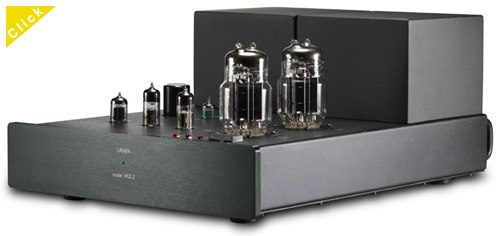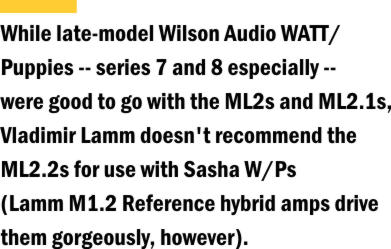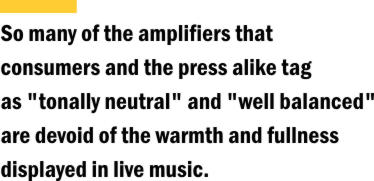Lamm Industries • ML2.2 Mono Amplifiers
dozen years ago when Vladimir Lamm introduced his ML2 monoblocks, the perception and reality of single-ended-triode (SET) amplifiers changed for the better. At 18 watts, the ML2 would never be accused of offering limitless power, but it did possess the ability to drive real-world loads that other SET amps could barely budge, and it did so with the pure tone and presence for which SET amps were known but without compromises at the frequency extremes. The ML2 dragged SET amps closer to the audio mainstream, even if its price of nearly $30,000 per pair was firmly anchored in the outer reaches.
Five years later, when the upgraded ML2.1 debuted, the amp's power output and price remained the same, as did its sound in general terms. But improved parts, including a new power transformer, also made for an amp that sounded slightly more powerful than the ML2, more transparent through the midrange and more controlled in the bass as well. The ML2.1 retained all that made the ML2 a special amp: the signature Lamm naturalness that caused so much of its competition, tube and solid state, to sound incomplete by comparison. When the ML2.2 was announced a year ago, the ML2 platform underwent much more than parts improvements. This could be forecast after Lamm's most expensive and impressive amp to date, the two-chassis-per-channel ML3 Signature, also of the SET persuasion, was unleashed upon audiophiles a few years ago. The ML2.2 borrows the input stage from this amp, using a single 12AX7A in the driver stage and parallel 6N6Ps thereafter. The power supply also needed to be beefed up to accommodate the requirements of the 6N6Ps. The pair of Russian 6C33C-B tubes remained -- one providing the power and the other acting as the voltage regulator. The ML3's output, 32 watts, is greater than the ML2.2's, which doesn't change from the 18 watts the amplifier has always offered. Earlier versions of the amp didn't have Lamm's remote turn-on circuit, however, and the ML2.2 does. This allows owners of Lamm preamps to power on and off their amps from the on/off switch of their preamps. All of the changes to the ML2.2 mean that ML2 and ML2.1 can't be upgraded; this was not a practice that Lamm adopted in any event, preferring instead to change their products far less frequently than is the industry norm. Vladimir Lamm is adamant about designing products right the first time and then leaving them alone. Even so, the ML2.2 represents the most significant change from the previous model of any Lamm product. s with the ML2 and ML2.1, owners adjust the bias and idle current of the ML2.2 with a high-quality volt-ohm meter. This is done via test points on the amplifier's top plate. Input is still via RCA or pseudo-balanced XLR located on the left-front of the amp, requiring an extra half-meter of interconnect to reach.
Speakers that are suitable for the amps include my reference Wilson Audio MAXX 3s and, based on my experience at CES, the Verity Audio Lohengrin IIs. Of course, any of the plethora of horn-loaded and single-driver speakers preferred for use with even lower-power SET amps would be suitable as well -- as would other speakers that I'm simply not familiar with. More than with any other SET amps, experimentation with the ML2.2s will yield some surprises in terms of which speakers they can drive without excuses. Experimentation will also lead to the best match in terms of preamps. I had three available, each of which would make it onto many best-of-the-best lists: the Audio Research Reference Anniversary, the Convergent Audio Technology SL1 Legend and the Lamm LL1 Signature. Before swapping among them, I would have predicted a draw in terms of my preference. I admire the totality of performance that all of these preamps represent. While they each have certain strengths, none has glaring weaknesses, the choice of one, so my thinking went, coming down to a matter of personal taste. But this wasn't the case; the Lamm LL1 Signature clearly sounded the best with the ML2.2s. Interestingly, the combination of the ML2.2s and LL1 wasn't a matter of like sonic signatures multiplying to create a sum greater than the parts, but rather of complementary personalities making for an outcome that was greater than either product alone. The LL1's drive and sense of forward momentum brought the amps to life in ways the two challengers couldn't equal, even with their considerable strengths. The Lamm combo sounded more lithe and athletic, its collective signature imposed on the speakers instead of the other way around. As I discovered when I reviewed the LL1, warm-up is crucial to hearing it at its best, with an hour being the minimum, as is the choice of power cords -- the throw-ins that come with it being better than some of the pricey cords I had. With inadequate warm-up and the wrong cords, there is some highlighting in the upper midrange that may enliven a dark-sounding speaker but didn't improve any of those I used. My point in rambling on about preamps is that your choice of speakers to use with the ML2.2s isn't the only thing to consider in order to mine the most from them. This is self-evident perhaps, but also worth stating, given that the difference with the LL1 Signature, even when compared with two other stellar preamps, was significant enough to be considered imperative.
Many of the things I consider the earmarks of accuracy come from my longtime use of Lamm amplifiers. I've owned a number of different models over the course of fifteen years, including ML2s and ML2.1s. To a piece, they have all gotten tone quality and overall balance right, presenting the music with true three-dimensional presence in the process. Lamm amps never sound tilted or hyped, and they always present a middle perspective -- neither forward nor recessed. If this applies to every Lamm amp, why consider the ML2.2s when, for instance, the M1.2s offer more power at a considerably lower price? Because what I describe above is only the starting point for the ML2.2s. There are specific ways that they surpass the Lamm hybrid amps, not to mention so many tube and solid-state contenders from other makers. It may seem illogical to begin a discussion of the sound of a SET amp with the bass, but, once again, the ML2.2 isn't a run-of-the-mill SET amp. Its bass is acutely aligned with the rest of the sonic spectrum: exacting in terms of dynamic shifts and pitch definition, and able to impart the expressive texture of instruments throughout its range. While it's more bloomy than tightly drawn, there is no mush or flab. And the amps were able to achieve all of this while dealing with the large woofers of Wilson MAXX 3s -- and were never short of the power needed to push quick-paced, dynamically challenging fare such as the Mobile Fidelity SACD of Patricia Barber's Modern Cool [Mobile Fidelity UDSACD 2003]. The soundscape of "Touch of Trash" is broad and the frequency and dynamic ranges wide, but the ML2.2s never seemed taxed by any of it, even as the cut progressed and the music began to percolate. "Could another SET amp handle this?" my listening notes asked rhetorically. In my experience, only the Lamm ML3s can, and the ML2.2s share part of their circuitry. Modern Cool also shows off the ML2.2's keen tonality. Those used to so many of the solid-state amps available today will think that the ML2.2 sounds a touch -- or more -- dark, but those other amps have skewed the collective range of tonality toward the treble, altering the perception of listeners. In the past when discussing Lamm amplifiers, I've suggested the following test: listen to someone talk (or, even better, sing) in your listening space, and then put on just about any recording -- especially a CD. Doesn't the music sound lighter and less substantial in tone than the live voice? It almost always does to me -- except when I'm listening to one of Vladimir Lamm's amps, and especially the ML2.2, whose sound is substantial by default, not to mention spectrally correct from top to bottom. In the mids, there is no highlighting, even as the region reminds us again why SET amps are prized. Roundness -- the sense that images are not flat and lacking in dimension -- and density are in full redolence, giving voices especially a sense of immediacy that's not a function of transient speed, for instance, but rather the extreme physicality of the presentation. The ML2.2s are physical, which is all the more noteworthy because of their dozen and a half watts of power. Along with this, however, is vitality -- a vast amount of musical information that is the sign of another intricate balance this amp achieves: between sheer resolving power and standard-setting naturalness. The ML2.2s are certainly detailed amps, but they achieve this with grace, not ruthlessness. Analog was especially impressive, as this is its stock signature as well. Playing some of the 45rpm sets coming from Chad Kassem's new record-pressing plant, Quality Record Pressings, was an act of near-constant revelation, as small but musically relevant details -- a light touch on the piano, a breath taken in or let out -- seemed to have grander circumstance and more elemental meaning.
More competitive in terms of price are the Atma-Sphere MA-2 Mk 3.1 monoblocks ($41,600 per pair) that I reviewed in October. These output-transformerless amps are extraordinary overall and peerless in a couple of ways. Like the ML2.2, the Atma-Sphere MA-2 Mk 3.1 certainly has an impressive midrange, but the two amps sound very different through this most important region. With the Atma-Sphere amps, it's transparency, the sense of nothingness between the equipment and the music, that is their most distinguishing feature. It's unmatched as well, at least in my experience, and probably more attention-grabbing than the ML2.2s' tonality and balance. The Atma-Sphere amps are certainly more powerful than the ML2.2s, but after a certain point that's within the ML2.2's comfort zone, this is not at all noticeable. The Atma-Sphere amps display more resolute attack, portraying greater leading edge and less image mass than the Lamm amps. The bass of both is good for tube amps, but the ML2.2's low frequencies are a little better integrated into the totality of the music they make. There is a strong element of mutual exclusion to the ML2.2s and MA-2 Mk 3.1s, coming both from the vast difference in output power and their sonic personalities. Both put a different spin on the "accuracy" debate and only underscore the fact that each of us who prize musical reproduction is an island, the creator and keeper of our personal list of important sonic qualities. I would be surprised if one or the other of these amps didn't achieve those things at the top of most lists. here are many ways to sum up the Lamm ML2.2s. They represent more than a worthy upgrade to the ML2 and ML2.1; they can drive speakers that would choke other SET designs; they offer a nearly unique collection of traits, including realistic tone and balance, copious weight and dimension; they have rather un-SET-like bass. What makes them most memorable to me, and I suspect to you if you get to audition them, is that they quickly override the part of the brain that cooks up these thoughts to begin with. You may sit down to listen to the amps, but in short order you'll realize that you're actually listening to the music, so quickly do they make you forget about them. This may be an overused reviewing convention, but it's also the highest goal of hi-fi -- to transcend the equipment, what the ML2.2s do as a matter of course. In his inimitable way, Vladimir Lamm once told me years
ago that the ideal review of his equipment would be just one word long. However, I don't
recall that he ever told me what that magic word is. "Right" and
"real" seem like good guesses, and they both fit the ML2.2.
|


 Beyond these things, the
other in-use consideration for ML2.2s is the sensitivity of the partnering speaker. While
the amps can drive speakers that seem on paper unsuited for their 18 watts, like the
Wilson Audio Sophia 3, they can't ideally drive speakers that need a healthy amount of
power and current to come alive. Among these in my firsthand experience are the Tidal
Sunrays, which don't represent a particularly punishing load but do need more oomph than
the ML2.2s can deliver in order to sound anything but dynamically limp. While late-model
Wilson Audio WATT/Puppies -- series 7 and 8 especially -- were good to go with the ML2s
and ML2.1s, Vladimir Lamm doesn't recommend the ML2.2s for use with Sasha W/Ps (Lamm M1.2
Reference hybrid amps drive them gorgeously, however).
Beyond these things, the
other in-use consideration for ML2.2s is the sensitivity of the partnering speaker. While
the amps can drive speakers that seem on paper unsuited for their 18 watts, like the
Wilson Audio Sophia 3, they can't ideally drive speakers that need a healthy amount of
power and current to come alive. Among these in my firsthand experience are the Tidal
Sunrays, which don't represent a particularly punishing load but do need more oomph than
the ML2.2s can deliver in order to sound anything but dynamically limp. While late-model
Wilson Audio WATT/Puppies -- series 7 and 8 especially -- were good to go with the ML2s
and ML2.1s, Vladimir Lamm doesn't recommend the ML2.2s for use with Sasha W/Ps (Lamm M1.2
Reference hybrid amps drive them gorgeously, however). ike every audiophile, I
have compiled a running list of the sonic qualities that matter most to me. These are the
things that best suspend disbelief, as they most closely approximate live sound -- to my
ears at least. Among them -- and at the top of the tally -- are realistic tone and
spectral balance, along with image weight and dimension. In complex ways, all of these
things work in concert, the success or failure of one affecting the same with the others.
So many of the amplifiers that consumers and the press alike tag as "tonally
neutral" and "well balanced" are devoid of the warmth and fullness
displayed in live music. These amps often sound tonally threadbare, their balance
invariably leaning toward the treble, which means there is no true balance. This
fundamental skewing of reality has a domino effect, causing performers to sound
disembodied instead of present, flat and flimsy instead of rounded and real. Given all of
this, it would be easy to argue that the word "accuracy" has no meaning. I would
simply say that because of misuse it has the wrong meaning.
ike every audiophile, I
have compiled a running list of the sonic qualities that matter most to me. These are the
things that best suspend disbelief, as they most closely approximate live sound -- to my
ears at least. Among them -- and at the top of the tally -- are realistic tone and
spectral balance, along with image weight and dimension. In complex ways, all of these
things work in concert, the success or failure of one affecting the same with the others.
So many of the amplifiers that consumers and the press alike tag as "tonally
neutral" and "well balanced" are devoid of the warmth and fullness
displayed in live music. These amps often sound tonally threadbare, their balance
invariably leaning toward the treble, which means there is no true balance. This
fundamental skewing of reality has a domino effect, causing performers to sound
disembodied instead of present, flat and flimsy instead of rounded and real. Given all of
this, it would be easy to argue that the word "accuracy" has no meaning. I would
simply say that because of misuse it has the wrong meaning.  If you want generous detail
and bodily presence from vocalists, there is only one amp in the same league as the ML2.2.
You guessed it -- the ML3. Where these amps, the mightiest from Vladimir Lamm, surpass the
ML2.2s is in terms of their transient speed and definition, their sheer drive (they offer
almost twice the power) and, for lack of a better way to put it, their musical savoir
fare -- a certain hard-to-define sophistication that is nonetheless easy to hear and
appreciate. Oh, and there's also the small matter of a six-figure difference in price. As
someone who heard the ML3s in my system a few years ago said, "I want them. I can't
afford them, but I want them." Amen to that.
If you want generous detail
and bodily presence from vocalists, there is only one amp in the same league as the ML2.2.
You guessed it -- the ML3. Where these amps, the mightiest from Vladimir Lamm, surpass the
ML2.2s is in terms of their transient speed and definition, their sheer drive (they offer
almost twice the power) and, for lack of a better way to put it, their musical savoir
fare -- a certain hard-to-define sophistication that is nonetheless easy to hear and
appreciate. Oh, and there's also the small matter of a six-figure difference in price. As
someone who heard the ML3s in my system a few years ago said, "I want them. I can't
afford them, but I want them." Amen to that.